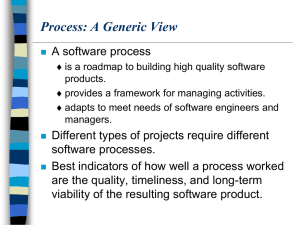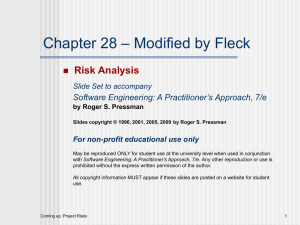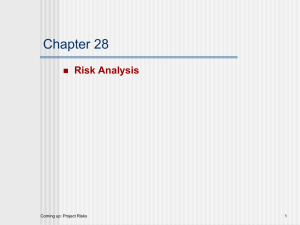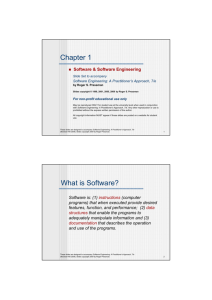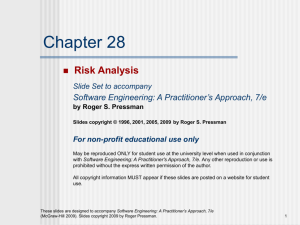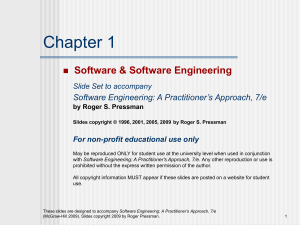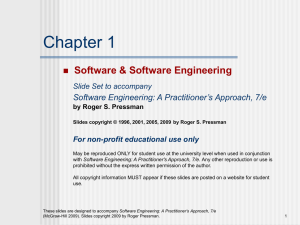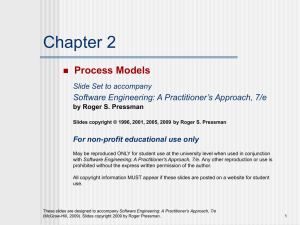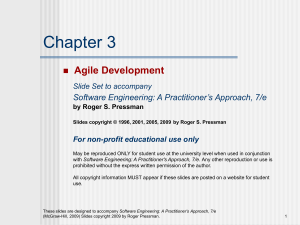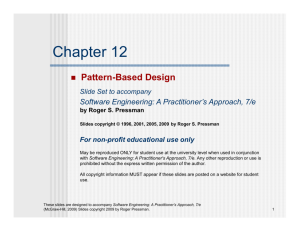Slide Set to accompany Web Engineering: A Practitioner Approach
advertisement
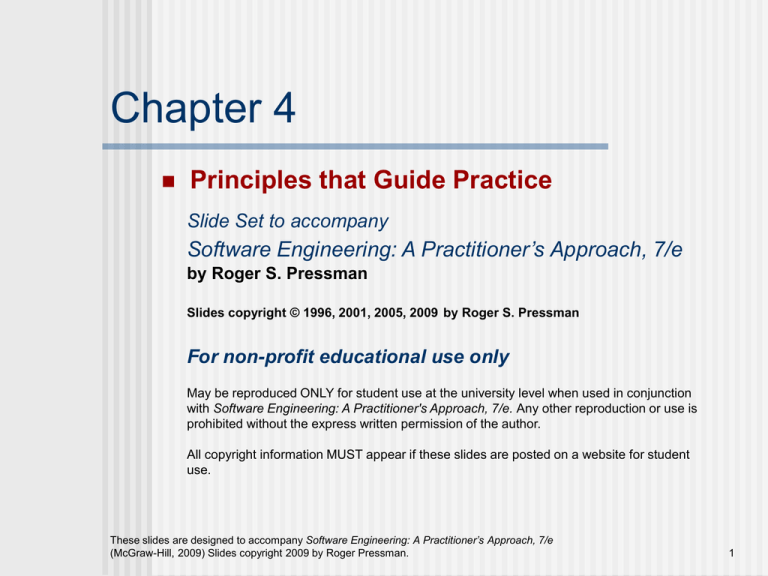
Chapter 4 Principles that Guide Practice Slide Set to accompany Software Engineering: A Practitioner’s Approach, 7/e by Roger S. Pressman Slides copyright © 1996, 2001, 2005, 2009 by Roger S. Pressman For non-profit educational use only May be reproduced ONLY for student use at the university level when used in conjunction with Software Engineering: A Practitioner's Approach, 7/e. Any other reproduction or use is prohibited without the express written permission of the author. All copyright information MUST appear if these slides are posted on a website for student use. These slides are designed to accompany Software Engineering: A Practitioner’s Approach, 7/e (McGraw-Hill, 2009) Slides copyright 2009 by Roger Pressman. 1 Software Engineering Knowledge You often hear people say that software development knowledge has a 3-year half-life: half of what you need to know today will be obsolete within 3 years. In the domain of technology-related knowledge, that’s probably about right. But there is another kind of software development knowledge—a kind that I think of as "software engineering principles"—that does not have a three-year half-life. These software engineering principles are likely to serve a professional programmer throughout his or her career. Steve McConnell These slides are designed to accompany Software Engineering: A Practitioner’s Approach, 7/e (McGraw-Hill, 2009) Slides copyright 2009 by Roger Pressman. 2 Principles that Guide Process - I Principle #1. Be agile. Whether the process model you choose is prescriptive or agile, the basic tenets of agile development should govern your approach. Principle #2. Focus on quality at every step. The exit condition for every process activity, action, and task should focus on the quality of the work product that has been produced. Principle #3. Be ready to adapt. Process is not a religious experience and dogma has no place in it. When necessary, adapt your approach to constraints imposed by the problem, the people, and the project itself. Principle #4. Build an effective team. Software engineering process and practice are important, but the bottom line is people. Build a self-organizing team that has mutual trust and respect. These slides are designed to accompany Software Engineering: A Practitioner’s Approach, 7/e (McGraw-Hill, 2009) Slides copyright 2009 by Roger Pressman. 3 Principles that Guide Process - II Principle #5. Establish mechanisms for communication and coordination. Projects fail because important information falls into the cracks and/or stakeholders fail to coordinate their efforts to create a successful end product. Principle #6. Manage change. The approach may be either formal or informal, but mechanisms must be established to manage the way changes are requested, assessed, approved and implemented. Principle #7. Assess risk. Lots of things can go wrong as software is being developed. It’s essential that you establish contingency plans. Principle #8. Create work products that provide value for others. Create only those work products that provide value for other process activities, actions or tasks. These slides are designed to accompany Software Engineering: A Practitioner’s Approach, 7/e (McGraw-Hill, 2009) Slides copyright 2009 by Roger Pressman. 4 Principles that Guide Practice Principle #1. Divide and conquer. Stated in a more technical manner, analysis and design should always emphasize separation of concerns (SoC). Principle #2. Understand the use of abstraction. At it core, an abstraction is a simplification of some complex element of a system used to communication meaning in a single phrase. Principle #3. Strive for consistency. A familiar context makes software easier to use. Principle #4. Focus on the transfer of information. Pay special attention to the analysis, design, construction, and testing of interfaces. These slides are designed to accompany Software Engineering: A Practitioner’s Approach, 7/e (McGraw-Hill, 2009) Slides copyright 2009 by Roger Pressman. 5 Principles that Guide Practice Principle #5. Build software that exhibits effective modularity. Separation of concerns (Principle #1) establishes a philosophy for software. Modularity provides a mechanism for realizing the philosophy. Principle #6. Look for patterns. Brad Appleton [App00] suggests that: “The goal of patterns within the software community is to create a body of literature to help software developers resolve recurring problems encountered throughout all of software development. Principle #7. When possible, represent the problem and its solution from a number of different perspectives. Principle #8. Remember that someone will maintain the software. These slides are designed to accompany Software Engineering: A Practitioner’s Approach, 7/e (McGraw-Hill, 2009) Slides copyright 2009 by Roger Pressman. 6 Communication Principles Principle #1. Listen. Try to focus on the speaker’s words, rather than formulating your response to those words. Principle # 2. Prepare before you communicate. Spend the time to understand the problem before you meet with others. Principle # 3. Someone should facilitate the activity. Every communication meeting should have a leader (a facilitator) to keep the conversation moving in a productive direction; (2) to mediate any conflict that does occur, and (3) to ensure than other principles are followed. Principle #4. Face-to-face communication is best. But it usually works better when some other representation of the relevant information is present. These slides are designed to accompany Software Engineering: A Practitioner’s Approach, 7/e (McGraw-Hill, 2009) Slides copyright 2009 by Roger Pressman. 7 Communication Principles Principle # 5. Take notes and document decisions. Someone participating in the communication should serve as a “recorder” and write down all important points and decisions. Principle # 6. Strive for collaboration. Collaboration and consensus occur when the collective knowledge of members of the team is combined … Principle # 7. Stay focused, modularize your discussion. The more people involved in any communication, the more likely that discussion will bounce from one topic to the next. Principle # 8. If something is unclear, draw a picture. Principle # 9. (a) Once you agree to something, move on; (b) If you can’t agree to something, move on; (c) If a feature or function is unclear and cannot be clarified at the moment, move on. Principle # 10. Negotiation is not a contest or a game. It works best when both parties win. These slides are designed to accompany Software Engineering: A Practitioner’s Approach, 7/e (McGraw-Hill, 2009) Slides copyright 2009 by Roger Pressman. 8 Planning Principles Principle #1. Understand the scope of the project. It’s impossible to use a roadmap if you don’t know where you’re going. Scope provides the software team with a destination. Principle #2. Involve the customer in the planning activity. The customer defines priorities and establishes project constraints. Principle #3. Recognize that planning is iterative. A project plan is never engraved in stone. As work begins, it very likely that things will change. Principle #4. Estimate based on what you know. The intent of estimation is to provide an indication of effort, cost, and task duration, based on the team’s current understanding of the work to be done. These slides are designed to accompany Software Engineering: A Practitioner’s Approach, 7/e (McGraw-Hill, 2009) Slides copyright 2009 by Roger Pressman. 9 Planning Principles Principle #5. Consider risk as you define the plan. If you have identified risks that have high impact and high probability, contingency planning is necessary. Principle #6. Be realistic. People don’t work 100 percent of every day. Principle #7. Adjust granularity as you define the plan. Granularity refers to the level of detail that is introduced as a project plan is developed. Principle #8. Define how you intend to ensure quality. The plan should identify how the software team intends to ensure quality. Principle #9. Describe how you intend to accommodate change. Even the best planning can be obviated by uncontrolled change. Principle #10. Track the plan frequently and make adjustments as required. Software projects fall behind schedule one day at a time. These slides are designed to accompany Software Engineering: A Practitioner’s Approach, 7/e (McGraw-Hill, 2009) Slides copyright 2009 by Roger Pressman. 10 Modeling Principles In software engineering work, two classes of models can be created: Requirements models (also called analysis models) represent the customer requirements by depicting the software in three different domains: the information domain, the functional domain, and the behavioral domain. Design models represent characteristics of the software that help practitioners to construct it effectively: the architecture, the user interface, and component-level detail. These slides are designed to accompany Software Engineering: A Practitioner’s Approach, 7/e (McGraw-Hill, 2009) Slides copyright 2009 by Roger Pressman. 11 Requirements Modeling Principles Principle #1. The information domain of a problem must be represented and understood. Principle #2. The functions that the software performs must be defined. Principle #3. The behavior of the software (as a consequence of external events) must be represented. Principle #4. The models that depict information, function, and behavior must be partitioned in a manner that uncovers detail in a layered (or hierarchical) fashion. Principle #5. The analysis task should move from essential information toward implementation detail. These slides are designed to accompany Software Engineering: A Practitioner’s Approach, 7/e (McGraw-Hill, 2009) Slides copyright 2009 by Roger Pressman. 12 Design Modeling Principles Principle #1. Design should be traceable to the requirements model. Principle #2. Always consider the architecture of the system to be built. Principle #3. Design of data is as important as design of processing functions. Principle #5. User interface design should be tuned to the needs of the end-user. However, in every case, it should stress ease of use. Principle #6. Component-level design should be functionally independent. Principle #7. Components should be loosely coupled to one another and to the external environment. Principle #8. Design representations (models) should be easily understandable. Principle #9. The design should be developed iteratively. With each iteration, the designer should strive for greater simplicity. These slides are designed to accompany Software Engineering: A Practitioner’s Approach, 7/e (McGraw-Hill, 2009) Slides copyright 2009 by Roger Pressman. 13 Agile Modeling Principles Principle #1. The primary goal of the software team is to build software, not create models. Principle #2. Travel light—don’t create more models than you need. Principle #3. Strive to produce the simplest model that will describe the problem or the software. Principle #4. Build models in a way that makes them amenable to change. Principle #5. Be able to state an explicit purpose for each model that is created. Principle #6. Adapt the models you develop to the system at hand. Principle #7. Try to build useful models, but forget about building perfect models. Principle #8. Don’t become dogmatic about the syntax of the model. If it communicates content successfully, representation is secondary. Principle #9. If your instincts tell you a model isn’t right even though it seems okay on paper, you probably have reason to be concerned. Principle #10. Get feedback as soon as you can. These slides are designed to accompany Software Engineering: A Practitioner’s Approach, 7/e (McGraw-Hill, 2009) Slides copyright 2009 by Roger Pressman. 14 Construction Principles The construction activity encompasses a set of coding and testing tasks that lead to operational software that is ready for delivery to the customer or end-user. Coding principles and concepts are closely aligned programming style, programming languages, and programming methods. Testing principles and concepts lead to the design of tests that systematically uncover different classes of errors and to do so with a minimum amount of time and effort. These slides are designed to accompany Software Engineering: A Practitioner’s Approach, 7/e (McGraw-Hill, 2009) Slides copyright 2009 by Roger Pressman. 15 Preparation Principles Before you write one line of code, be sure you: • Understand of the problem you’re trying to solve. • Understand basic design principles and concepts. • Pick a programming language that meets the needs of the software to be built and the environment in which it will operate. • Select a programming environment that provides tools that will make your work easier. • Create a set of unit tests that will be applied once the component you code is completed. These slides are designed to accompany Software Engineering: A Practitioner’s Approach, 7/e (McGraw-Hill, 2009) Slides copyright 2009 by Roger Pressman. 16 Coding Principles As you begin writing code, be sure you: • Constrain your algorithms by following structured programming [Boh00] practice. • Consider the use of pair programming • Select data structures that will meet the needs of the design. • Understand the software architecture and create interfaces that are consistent with it. • Keep conditional logic as simple as possible. • Create nested loops in a way that makes them easily testable. • Select meaningful variable names and follow other local coding standards. • Write code that is self-documenting. • Create a visual layout (e.g., indentation and blank lines) that aids understanding. These slides are designed to accompany Software Engineering: A Practitioner’s Approach, 7/e (McGraw-Hill, 2009) Slides copyright 2009 by Roger Pressman. 17 Validation Principles After you’ve completed your first coding pass, be sure you: • Conduct a code walkthrough when appropriate. • Perform unit tests and correct errors you’ve uncovered. • Refactor the code. These slides are designed to accompany Software Engineering: A Practitioner’s Approach, 7/e (McGraw-Hill, 2009) Slides copyright 2009 by Roger Pressman. 18 Testing Principles Al Davis [Dav95] suggests the following: Principle #1. All tests should be traceable to customer requirements. Principle #2. Tests should be planned long before testing begins. Principle #3. The Pareto principle applies to software testing. Principle #4. Testing should begin “in the small” and progress toward testing “in the large.” Principle #5. Exhaustive testing is not possible. These slides are designed to accompany Software Engineering: A Practitioner’s Approach, 7/e (McGraw-Hill, 2009) Slides copyright 2009 by Roger Pressman. 19 Deployment Principles Principle #1. Customer expectations for the software must be managed. Too often, the customer expects more than the team has promised to deliver, and disappointment occurs immediately. Principle #2. A complete delivery package should be assembled and tested. Principle #3. A support regime must be established before the software is delivered. An end-user expects responsiveness and accurate information when a question or problem arises. Principle #4. Appropriate instructional materials must be provided to end-users. Principle #5. Buggy software should be fixed first, delivered later. These slides are designed to accompany Software Engineering: A Practitioner’s Approach, 7/e (McGraw-Hill, 2009) Slides copyright 2009 by Roger Pressman. 20
